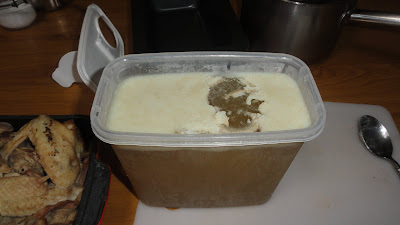Charcuterie is the culinary term for meats such as bacon, ham, sausages, terrines and pâtés. I delved into the wonderful world of charcuterie recently with an old favourite - brawn as it is known in Australia and the UK, or headcheese as it is know in north America. These types of meats developed as a way of preserving meat before canning and refrigeration. Now they're seen in may countries as specialist meats often sold only in delicatessens.
After spending a night in the fridge, the gelatinous stock held a layer of fat on the top. It was easily scraped off and the stock reheated to continue the process.
When cooked for a couple of hours, the meat and bones yield their natural gelatine which was what I was after. I wanted to see if I could make my own without using any added gelatine and while it formed into a good loaf, it didn't hold together well when sliced. It tasted good though. One of the added benefits of making brawn in the old days was that it helped the housewife avoid waste and use the entire animal. Traditionally made with a pig's head and feet, I made mine using chicken wings and a pork shoulder. Next time I do it, I'll add a couple of sheets of gelatine.
I boiled the meats for about three hours with some bay leaves, peppercorns, a cup of apple cider vinegar and an onion and allowed them to cool. Usually the brawn is made straight away but I wanted to remove the fat from the liquid and when I stored it in the fridge overnight, that is what I did the next morning. Then I reheated the liquid, added the finely chopped meat and shredded chicken wing meat, two finely chopped green onions, chopped fresh parsley, red capsicum/pepper, two tablespoons apple cider vinegar, salt and pepper and packed it all into some loaf tins. Stored overnight in the fridge, it came out of the tin the next day and although the slices don't hold together well, it makes a very good lunchtime sandwich on homemade sourdough.



